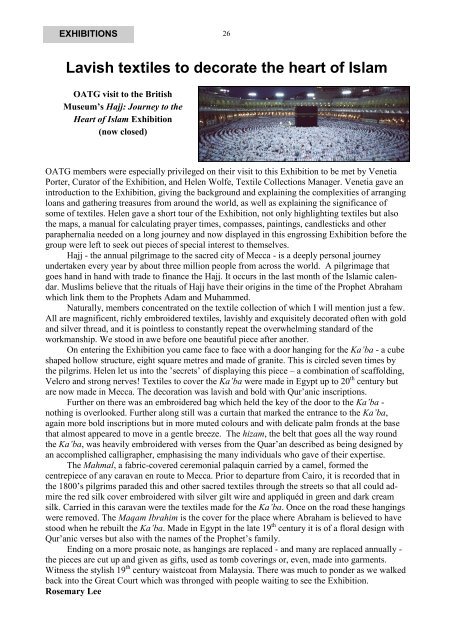ASIAN TEXTILES - OATG. Oxford Asian Textile Group
ASIAN TEXTILES - OATG. Oxford Asian Textile Group
ASIAN TEXTILES - OATG. Oxford Asian Textile Group
You also want an ePaper? Increase the reach of your titles
YUMPU automatically turns print PDFs into web optimized ePapers that Google loves.
EXHIBITIONS26Lavish textiles to decorate the heart of Islam<strong>OATG</strong> visit to the BritishMuseum’s Hajj: Journey to theHeart of Islam Exhibition(now closed)<strong>OATG</strong> members were especially privileged on their visit to this Exhibition to be met by VenetiaPorter, Curator of the Exhibition, and Helen Wolfe, <strong>Textile</strong> Collections Manager. Venetia gave anintroduction to the Exhibition, giving the background and explaining the complexities of arrangingloans and gathering treasures from around the world, as well as explaining the significance ofsome of textiles. Helen gave a short tour of the Exhibition, not only highlighting textiles but alsothe maps, a manual for calculating prayer times, compasses, paintings, candlesticks and otherparaphernalia needed on a long journey and now displayed in this engrossing Exhibition before thegroup were left to seek out pieces of special interest to themselves.Hajj - the annual pilgrimage to the sacred city of Mecca - is a deeply personal journeyundertaken every year by about three million people from across the world. A pilgrimage thatgoes hand in hand with trade to finance the Hajj. It occurs in the last month of the Islamic calendar.Muslims believe that the rituals of Hajj have their origins in the time of the Prophet Abrahamwhich link them to the Prophets Adam and Muhammed.Naturally, members concentrated on the textile collection of which I will mention just a few.All are magnificent, richly embroidered textiles, lavishly and exquisitely decorated often with goldand silver thread, and it is pointless to constantly repeat the overwhelming standard of theworkmanship. We stood in awe before one beautiful piece after another.On entering the Exhibition you came face to face with a door hanging for the Ka’ba - a cubeshaped hollow structure, eight square metres and made of granite. This is circled seven times bythe pilgrims. Helen let us into the ’secrets’ of displaying this piece – a combination of scaffolding,Velcro and strong nerves! <strong>Textile</strong>s to cover the Ka’ba were made in Egypt up to 20 th century butare now made in Mecca. The decoration was lavish and bold with Qur’anic inscriptions.Further on there was an embroidered bag which held the key of the door to the Ka’ba -nothing is overlooked. Further along still was a curtain that marked the entrance to the Ka’ba,again more bold inscriptions but in more muted colours and with delicate palm fronds at the basethat almost appeared to move in a gentle breeze. The hizam, the belt that goes all the way roundthe Ka’ba, was heavily embroidered with verses from the Quar’an described as being designed byan accomplished calligrapher, emphasising the many individuals who gave of their expertise.The Mahmal, a fabric-covered ceremonial palaquin carried by a camel, formed thecentrepiece of any caravan en route to Mecca. Prior to departure from Cairo, it is recorded that inthe 1800’s pilgrims paraded this and other sacred textiles through the streets so that all could admirethe red silk cover embroidered with silver gilt wire and appliquéd in green and dark creamsilk. Carried in this caravan were the textiles made for the Ka’ba. Once on the road these hangingswere removed. The Maqam Ibrahim is the cover for the place where Abraham is believed to havestood when he rebuilt the Ka’ba. Made in Egypt in the late 19 th century it is of a floral design withQur’anic verses but also with the names of the Prophet’s family.Ending on a more prosaic note, as hangings are replaced - and many are replaced annually -the pieces are cut up and given as gifts, used as tomb coverings or, even, made into garments.Witness the stylish 19 th century waistcoat from Malaysia. There was much to ponder as we walkedback into the Great Court which was thronged with people waiting to see the Exhibition.Rosemary Lee
















